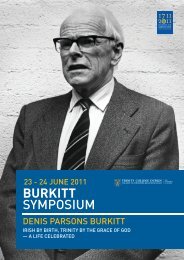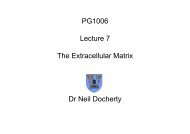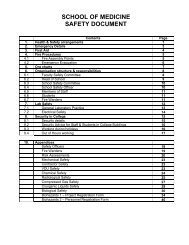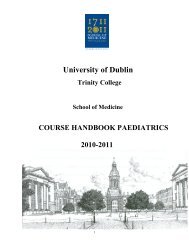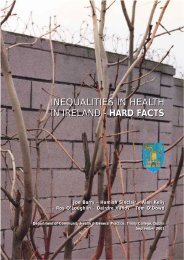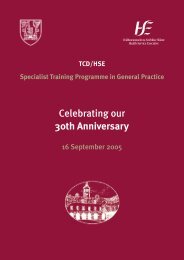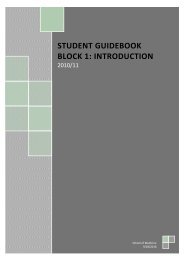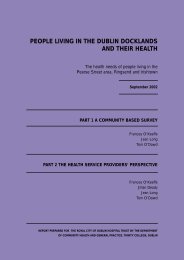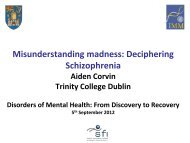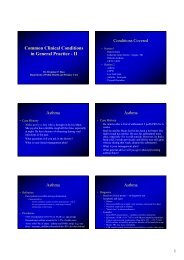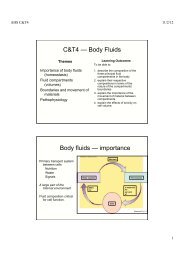Midland Regional Hospital Mullingar
Midland Regional Hospital Mullingar
Midland Regional Hospital Mullingar
- No tags were found...
You also want an ePaper? Increase the reach of your titles
YUMPU automatically turns print PDFs into web optimized ePapers that Google loves.
<strong>Midland</strong> <strong>Regional</strong> <strong>Hospital</strong> <strong>Mullingar</strong>2011 – 2012 Pre-Placement InformationThe <strong>Midland</strong> <strong>Regional</strong> <strong>Hospital</strong> <strong>Mullingar</strong> is a 202 bed acute general andmaternity hospital. It provides a wide range of acute hospital services on aninpatient, day case and outpatient basis. The Physiotherapy Departmentcomprises approx. 15 physios. The most common placement is in the area ofrespiratory but neurology and gerontology (inpatient) or outpatients (in<strong>Mullingar</strong> or St Josephs Care Centre Longford) may also be available.General Information -The Physiotherapy Department is located on the ground floor of the hospital;walk straight in past the main reception, turn right at the end of the corridorbefore the lifts. The department is halfway down this corridor on your right.Telephone No: <strong>Hospital</strong> Reception: 044 9340221Physiotherapy Dept: 044 9394654Physiotherapy Manager:Contact Physiotherapist:Mary Wallace, Department ManagerKate Plunkett, Practice Tutor044 9394654kate.plunkett@hse.ieHours of Work: Monday – Thursday: 9:30 – 5:30Friday: 9:30 – 5:15Lunch: 1-2Break: 11 – 11:30Public Transport:Accommodation:Check in on First Day:Trains - Dublin to Sligo line. www.Irishrail.ieTimetables may change every few monthsStation is 15minutes walk from the hospitalBus - www.buseireann.ieThere is a bus stop beside the hospitalRailway House B+B Dominick St <strong>Mullingar</strong>,044 9341142. This B+B accommodatesmedical students also, so it would need to bebooked in advance. It is 10 minutes walk fromthe hospital. This is the accommodationstudents usually use. Please notereimbursement is available to students foraccommodation on Monday to Thursdayonly.Outpatient Reception of Physiotherapy Dept1
Uniform:As per Student Uniform PolicyInfection Control:Students must not travel to and fromplacement in uniform. Changing rooms areavailable. You must change if leaving thehospital grounds for lunch.Infection Control guidelines available on-site.Facilities Available for Students -Computer/Internet, Changing room, Staff room for lunch- use offridge/microwave, staff canteen; locker for valuables; car parking -Please ensure that you have a 25 euro deposit on the first day ofplacement for a security/swipe card which is required to gain access toall areas of the hospital and the car park. 20 euro of this is refunded atthe end of placement once you return the card and receipt for thepayment.Educational Facilities -There is a hospital library on-site. Opening times change, check on arrival.The physiotherapy department or library can be used for study. Some readingmaterial is available in the department. Photocopying facilities are available.StethoscopesStudents going on placement to a respiratory area are requested to bring astethoscope with them. If you don’t have your own stethoscope you can loanone form Lucy Alpine (Practice Education Co-ordinator) before placementcommences. Please ensure you borrow this is good time before placementcommences.RESPIRATORY PLACEMENTThe respiratory placement covers the Intensive Care Unit (ICU), medicalwards, surgical wards and, caseload allowing, paediatric wards. There are twosenior and three rotational physiotherapists.Conditions/pathologies commonly encountered -- COPD, Bronchiectasis, Asthma- Abdominal surgery- Ventilated patients and ARDS- Pneumothorax- Tracheostomies- 6 minute walk tests- You may also see some general mobility patients or patients with CVA2
Other activities commonly experienced –- Cardiac rehab- Pulmonary rehab- Pulmonary function tests- Bronchoscopies- Pulmonary outreachIt is suggested that students familiarise themselves with the followingskills/techniques prior to beginning the placement -- Respiratory assessment including auscultation, ABGs, CXR interpretation- Medical respiratory conditions, including COPD, asthma, bronchiectasis- Surgical incisions and procedures – abdominal- Post-operative respiratory physiology and physiotherapy- Ventilation/perfusion- Thoracic anatomy and surface marking of the lungsSkills/ modalities likely to be used in this placement –- ACBT- Autogenic drainage- Patient handling skills and patient positioning- Manual chest techniques- Physiotherapy adjuncts – acapella, PEP, incentive spirometry- Exercise prescription- Outcome Measures: Pulse oximetry, Borg Breathlessness Scale, ElderlyMobility Scale, Berg Balance Scale- NIV- Suctioning, manual hyperinflation, ventilator use and ventilatorhyperinflation- Deliver an inservice/article reviewSuggested reading material –- Pryor & Prasad (2001) Physiotherapy for Respiratory and CardiacProblems. Churchill Livingstone- Hough A (2001) Physiotherapy in Respiratory Care – an evidence basedapproach to respiratory and cardiac conditions. (3rd edn) Nelson Thornes- Harden B. (2004) Emergency Physiotherapy: an on-call survival guideOUTPATIENT PLACEMENTSkills likely to be used -- Manual Handling- Joint mobilisation techniques – Maitlands, Mulligans Nags/Snags, Cyriax- Spinal and Peripheral joint assessment- Treatment post fractures- Treatment post TKR, ACL reconstruction, shoulder stabilisation3
- Core stability training- Soft tissue/myofascial/trigger point release- Use of traction- Designing home exercise programme, use of Physio ToolsOutcome measures used -- Goniometry- Jamar Hand Dynamometer- Visual Analogue Pain Scale- Rowland-Morris Disability Questionnaire- Falls Risk Assessment Tool- Berg Balance Scale- Rivermead Mobility Index- Various Post Surgery Protocols e.g. ACL reconstructionOther activities may be available -- Assessment and treatment at Falls programme- Assisting at Back Class- Observe acupuncture- Observe and assist at foot biomechanics and orthotic assessmentSuggested Reading -- Brukner, P & Khan, K (2002) Clinical Sports Medicine, 2nd Ed., TheMcGraw Hill companies Inc. London.- Corrigan, B., Maitland, G., (1994)Practical orthopaedic medicine,Butterworth Heinemann, Cambridge- Kesson, M, Atkins, E (2011) Orthopaedic Medicine, A Practical Approach.3 rd Ed., Elsevier Butterworth-Heinemann- Maitland, G. (1991) Peripheral Manipulation. 3rd Ed., ButterworthHeinemann, London- McRae R: Practical Fracture Treatment (Churchill Livingstone 1994)- Petty, N, Moore, A., (2002) Neuromuscular examination and assessment:a handbook for therapists, 2nd edition, Churchill Livingstone, Edinburgh4
ST JOSEPHS CARE CENTRE LONGFORD2011 – 2012 Pre-Placement InformationAddress:Physiotherapy Department,St. Joseph’s Care Centre,Dublin Road,LongfordContact: Martin Jennings or Catherine Brady 0433350112Longford.Physio@hse.iePractice Tutor:Kate Plunkett044 9394654kate.plunkett@hse.ieHours of Work: 9:30 – 5:30, Friday 9:30 – 5:15Lunch 1-2, Morning Break: 11 – 11:30Public Transport:Accommodation:Check in on First Day:Uniform:Infection Control:Longford town is on the Dublin-Sligo rail-linewww.irishrail.ie or on the Dublin to Ballina orSligo bus-route www.buseireann.ieWe do not have any accommodation links inLongford town but previous students haverented a room in a house (sourced on Daft)or have commuted from <strong>Mullingar</strong> whereother TCD students were located (approx 35min drive).Main Physiotherapy DepartmentAs per Student Uniform PolicyStudents must not travel to and fromplacement in uniform. You must change ifleaving the hospital grounds for lunch.Infection Control guidelines available on-site5
Facilities Available for students:Changing area, locker for valuables, staffcanteen, some reference literatureLibrary:No hospital library. Public Library opening:Monday and Wednesday 10.00-8.30pmTuesday and Thursday 10.00-5.30pmFriday 10.00-5.00pmOUTPATIENT PLACEMENTSkills likely to be used -- Manual Handling- Joint mobilisation techniques – Maitlands, Mulligans Nags/Snags- Spinal and Peripheral joint assessment- Treatment post fractures- Treatment post TKR, ACL reconstruction, shoulder stabilisation- Core stability training- Soft tissue/myofascial/trigger point release- Use of traction- Designing home exercise programme, use of Physio Tools- Observe and assist at foot biomechanics and orthotic assessmentOutcome measures used -- Goniometry- Jamar Hand Dynamometer- Visual Analogue Pain Scale- Rowland-Morris Disability Questionnaire- Falls Risk Assessment Tool- Berg Balance Scale- Rivermead Mobility Index- Various Post Surgery Protocols e.g. ACL reconstructionSuggested Reading -- Brukner, P & Khan, K (2002) Clinical Sports Medicine, 2nd Ed., TheMcGraw Hill companies Inc. London.- Corrigan, B., Maitland, G., (1994)Practical orthopaedic medicine,Butterworth Heinemann, Cambridge- Maitland, G. (1991) Peripheral Manipulation. 3rd Ed., ButterworthHeinemann, London- McRae R: Practical Fracture Treatment (Churchill Livingstone 1994)- Petty, N, Moore, A., (2002) Neuromuscular examination and assessment:a handbook for therapists, 2nd edition, Churchill Livingstone, Edinburgh6



